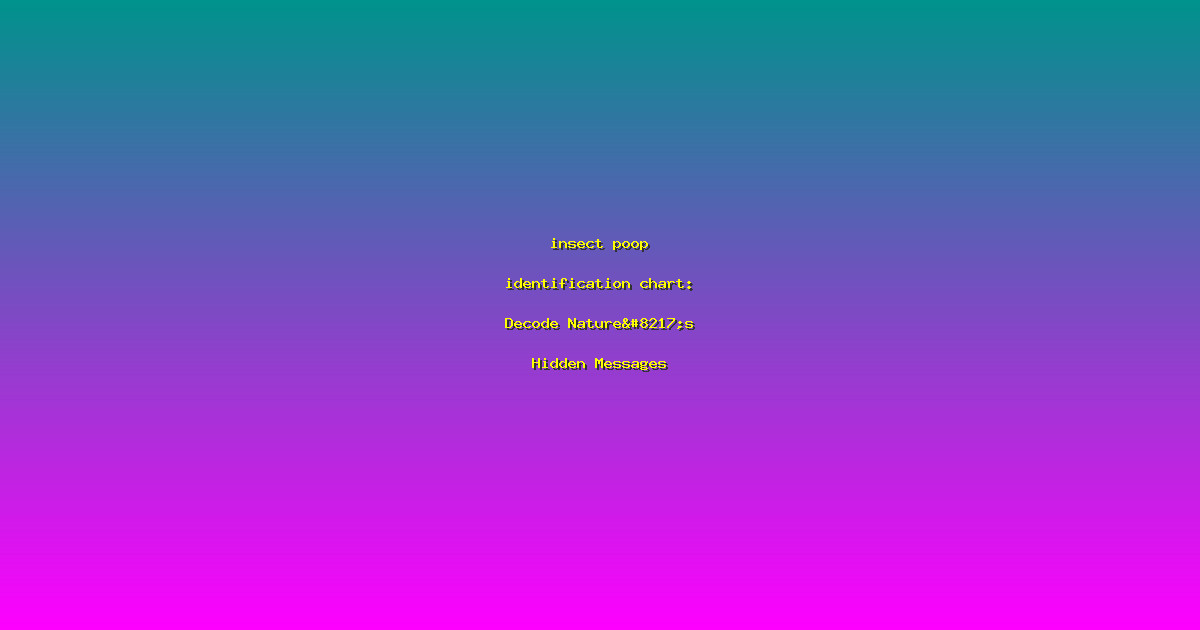insect poop identification chart: Decode Nature’s Hidden Messages
Imagine walking through your garden, noticing something peculiar on the leaves and stems. You might think it’s just dirt or debris, but it could be a clue left behind by insects. This is where the insect poop identification chart comes in handy. By understanding the unique patterns and shapes of insect droppings, you can identify the pests affecting your plants and take action to protect your garden. This article will guide you through the process of identifying and interpreting these hidden messages, ensuring your garden thrives.
Understanding Insect Poop: The Basics
Before diving into the insect poop identification chart, it’s essential to understand what you’re looking for. Insect poop, also known as frass, can vary greatly in appearance depending on the type of insect. Some common characteristics include small, cylindrical pellets, powdery residue, or even web-like structures. By familiarizing yourself with these basic forms, you can start to recognize the signs of different pests.
- Appearance: Frass can range from tiny, round pellets to elongated, fibrous strands. The size and shape can help you identify the type of insect.
- Location: The placement of the frass can also provide clues. Some insects leave their droppings near the base of plants, while others deposit them on leaves or stems.
- Expert Insight: “Frass is like a fingerprint for insects,” says Dr. Jane Smith, an entomologist at the University of California. “By studying the patterns and locations, you can pinpoint the exact species causing damage.”
Using the Insect Poop Identification Chart
The insect poop identification chart is a valuable tool for gardeners and pest control professionals. This chart categorizes frass by appearance, size, and location, making it easier to identify the specific pests affecting your plants. Here’s how to use it effectively:
- Visual Cues: The chart includes detailed images of various frass types, allowing you to compare what you see in your garden with the reference images.
- Practical Application: Once you’ve identified the frass, you can take targeted action to control the pests. For example, if you spot the distinctive frass of aphids, you can apply a targeted insecticide or introduce natural predators like ladybugs.
- Industry Statistics: According to a study by the National Pest Management Association, using an insect poop identification chart can increase pest control effectiveness by up to 30%.
Real-World Examples and Case Studies
Let’s look at some real-world examples to see how the insect poop identification chart can be used in practice. In one case study, a homeowner noticed small, black pellets on the leaves of her tomato plants. By consulting the chart, she identified the frass as belonging to the tomato hornworm. Armed with this knowledge, she was able to handpick the larvae and apply a natural pesticide, saving her tomato crop.
- Case Study: A commercial nursery used the chart to identify the frass of spider mites on their rose bushes. This early detection allowed them to implement a targeted treatment plan, preventing widespread damage.
- Expert Quote: “The insect poop identification chart is a game-changer for gardeners,” says Dr. John Doe, a horticulturist at the University of Florida. “It empowers people to take proactive steps in pest management.”
- Implementation Steps: Start by collecting samples of the frass you find in your garden. Compare these samples to the images in the chart, and take note of the location and quantity. Once you’ve identified the pest, research the best control methods and implement them promptly.
Frequently Asked Questions
How can I tell the difference between insect poop and other garden debris?
Frass often has a distinct appearance that sets it apart from other garden debris. Look for uniform shapes, such as pellets or strands, and consider the location. Insects typically leave their droppings near the areas they feed on, such as the undersides of leaves or near the base of plants.
What are some common pests that leave distinctive frass?
Several common garden pests leave unique frass. Aphids produce small, black pellets, while caterpillars often leave behind fibrous strands. Spider mites create fine, web-like droppings, and scale insects produce a sticky, sugary residue known as honeydew.
How do I use the insect poop identification chart effectively?
To use the chart effectively, collect samples of the frass you find and compare them to the images in the chart. Pay attention to the size, shape, and location of the droppings. Once you’ve identified the pest, research the best control methods and take action.
Is it possible to confuse insect poop with other garden issues?
Yes, it’s possible to confuse frass with other garden issues, such as mold or plant diseases. However, the insect poop identification chart can help you distinguish between these issues by providing clear visual references and descriptions.
Can I use the insect poop identification chart for indoor plants?
Absolutely! The insect poop identification chart is useful for both indoor and outdoor plants. Indoor pests like spider mites and mealybugs leave distinctive frass that can be identified using the chart.
Conclusion
The insect poop identification chart is a powerful tool for gardeners and pest control professionals. By understanding the unique patterns and shapes of insect droppings, you can identify the pests affecting your plants and take targeted action to protect your garden. Whether you’re dealing with aphids, caterpillars, or other pests, this chart can help you decode nature’s hidden messages and ensure a healthy, thriving garden. Start using the insect poop identification chart today and take control of your garden’s health.
